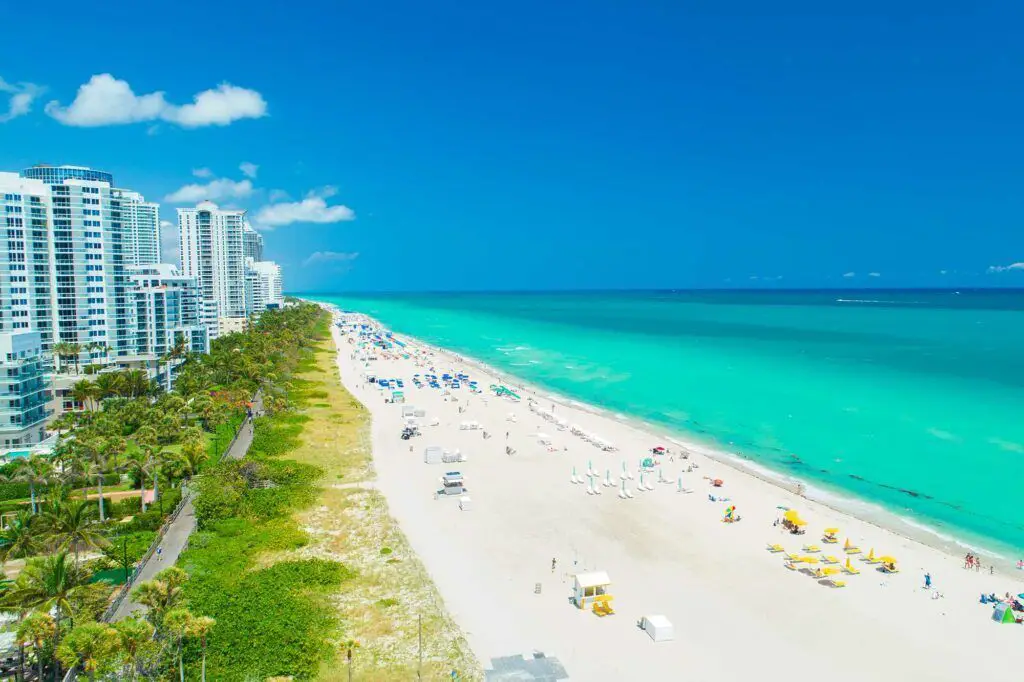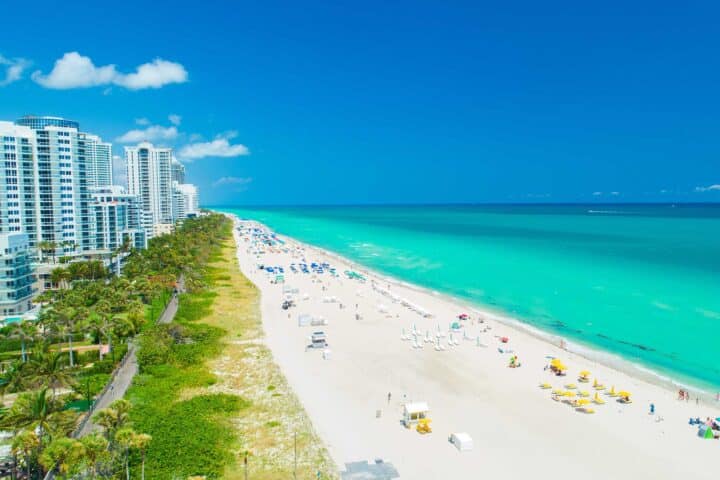Some people hate the cold. We understand that (although we’re big fans of snow). So where should you move if you don’t want to deal with winter anymore? That’s why we created this list of the top 10 warmest states in the US.
It shouldn’t be surprising that every state on our list is in the country’s southern half. The sun is directly overhead during the summer, maximizing warming and keeping these locales hotter than areas with less direct sunlight further north. While some states on our list experience some winter weather occasionally, it’s rare, and warm weather often returns in a few days.
We’ve based our list on official NOAA climate data using statewide annual average temperatures. In addition to ranking the warmest states in the US, we’ve also explained what makes them so warm. There are even a few surprises, including one state on this list with the same all-time record high temperature as Alaska, believe it or not.
So lets get started with our current list of the warmest states in the US.

What are the 10 warmest states in the US?
- Florida: The Sunshine State certainly lives up to its name. With its balmy subtropical climate, Florida boasts an average annual temperature of 71.5°F (21.9°C), making it the warmest state in the US. While the occasional cold spell in the winter might occur, it typically lasts for only a day or two before typical Florida weather returns.
- Hawaii: The beautiful island paradise of Hawaii comes in second place, offering a tropical climate with an average annual temperature of 70.2°F (21.2°C). As an island in the middle of the tropical Pacific, there isn’t much variation in the weather, which stays mild year-round and is one of the warmest states in the US in winter.
- Louisiana: With an average annual temperature of 67.2°F (19.6°C), Louisiana is the third warmest state. Its humid subtropical climate is characteristic of the southeastern US. The state is known for its hot and humid summers.
- Texas: Everything is bigger in Texas, including the heat. The Lone Star State, with an average annual temperature of 65.8°F (18.8°C), ranks as the fourth warmest state in the country. However, the northern part of the state isn’t as warm during the winter and often sees cold spells and wintry weather.
- Georgia: The Peach State enjoys a pleasant humid subtropical climate, with an average annual temperature of 64.3°F (17.9°C), making it the fifth warmest state. Like Louisiana, it also sees its share of humid, muggy weather during the summer, which many would consider oppressive.
- Mississippi: Boasting an average annual temperature of 64.3F (17.9°C), Mississippi ties for fifth place. It shares the same climate as Georgia, Louisiana, and Alabama, which appears next on our list.
- Alabama: With an average annual temperature of 63.7°F (17.6°C), Alabama is the seventh warmest state.
- South Carolina: Being slightly further north than the rest of the states on our list does make South Carolina a little cooler than the rest of the southeast, but not by much: with an average annual temperature of 63.4°F (17.4°C), it places eighth on our list.
- Arkansas: As a landlocked state, Arkansas doesn’t have the moderating effects of the warm Gulf of Mexico and subtropical Atlantic that other southeastern states do. While its climate is considered subtropical, this is mainly due to its often hot summers. Its winters can be considerably more variable, especially as you move north. It has an average annual temperature of 61.1°F (16.2°C).
- Arizona: Tying with Arkansas and rounding out our list is Arizona. While the state has the most variable temperatures of any state in this list so far, it’s one of the hottest states in the nation during the summer, with temperatures in the southern part of the state surpassing 100°F (37.8°C) for weeks at a time during the summer before Monsoon season starts.
Experience the fascinating world of weather with the second edition of Weather Watch: An Introduction to America's Weather and Climate. This book doesn't just explain weather and climate concepts—it brings them to life.
Weather Watch is perfect for teenagers and adults who wish to deepen their understanding of the dynamic world of meteorology. Simplifying the complex, this book breaks down the science of weather into smaller, easily digestible concepts, allowing you to build on your knowledge with each chapter.
Here's what to expect:
- Detailed insights on clouds, pressure and wind, reading weather maps, hurricanes, and tropical storms
- Enlightening discussion on climate change
- Essential guidance on purchasing a weather station
- Critical information on severe weather and tornadoes
- Learning how to forecast the weather yourself
This second edition comes completely reformatted with over 30 pages of new content, including advanced weather map analysis and space weather. It's more visually appealing with additional illustrations and graphics. Each chapter now ends with handy links for more in-depth learning, and sprinkled throughout the book are captivating American weather events, serving as real-life illustrations of introduced concepts.

Why Are These States So Warm?
Now that we’ve identified the top 10 warmest US states let’s delve into the reasons behind their balmy climates. We can group these states into two main regions: the Southeast and the Southwest.
Southeast
The southeastern states share a humid subtropical climate influenced by the warm waters of the Gulf of Mexico and the Atlantic Ocean. These bodies of water help moderate temperatures and contribute to the region’s humidity. The Southeast experiences hot, humid summers and mild winters, with frequent yearly rainfall.
The warmest states in the country are generally found here, especially along the Gulf Coast. As you move further inland, temperatures are not as warm, so we’d recommend moving to the southern parts of these states if you want the warmest weather (except for Florida, where much of the state remains warm year-round).
Southwest
Arizona’s warmth can be attributed to its desert climate. The state lies in the southwestern US, where the Sonoran, Mojave, and Chihuahuan Deserts converge. This arid environment results in hot, dry summers and mild winters. Elevation also plays a role in Arizona’s climate, with higher elevations experiencing cooler temperatures.
In fact, of any of the states on this list, Arizona is the only one where snow occurs regularly during the winter. Flagstaff, a mountain town in the northern part of the state, averages 100″ of snow each year, making it one of the snowiest towns in the country.
Hawaii
Hawaii’s location in the tropical Pacific is why it has a warm year-round climate. While humidity is something you’ll have to deal with, as an island state, no matter where you go, you’re feeling the moderating effects of the tropical Pacific. The good thing about this is extreme heat is rare: the state’s record high temperature of 100°F (37.8°C) has stood for nearly 100 years, which, if you can believe it is the same all-time record high for Alaska, both the coldest (relatively) in the nation!

Wrapping Up
If warmth is what you’re after, these top 10 warmest US states have you covered. From the humid subtropical climate of the Southeast to the arid desert climate of the Southwest, these states offer plenty of sunshine and warm temperatures year-round. Whether planning a vacation or considering a move, you can’t go wrong with any of these sun-soaked destinations. So grab your sunglasses, pack your sunscreen, and get ready to bask in the warmth of these amazing states!





